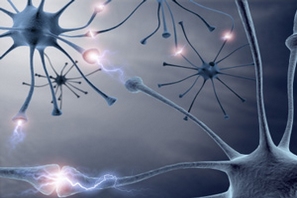A- Introduction:
– This is a rapidly extensive polyradiculoneuropathy
– Infringement perivascular inflammatory autoimmune nerves. And multifocal segmental demyelination affecting roots; plexus; nerve trunks and vegetative fibers. Reached very proximal or very distal to the blood-nerve permeability zone.
– Origin probable dysimmune. In 60% of cases, there is a prior infectious episode. Sometimes vaccination, serum therapy, surgery, dental …
B- Clinic:
* Inaugural signs: paresthesia of 4 ends; motor deficit predominant roots and lower limbs.These signs are bilateral and symmetrical; often back pain, myalgia, nerve root. Upward extension of sensory and motor disorders. The extension phase is less than 4 weeks.
* At the stage set:
– Three weeks on average (3 days to 6 weeks).
– Motor Deficit members 4 predominant in the lower limbs; bilateral and symmetrical with hypotonia without muscular atrophy or fasciculation. Achievement of cranial nerves (especially facial diplegia by reaching the VII).
– Deep tendon areflexia worth the 4 members
– Sensory Disorders objectives: smaller, predominantly on deep sensitivity (pallesthésie …).
– Vegetative disorders: arrhythmia; instability of the TA; vasomotor symptoms (sweating, salivation …).
– Negative signs: lack of sphincter disorders; absence of central characters (no pyramidal syndrome).
C- Investigations:
* Standard Biology (electrolytes, VS, NFS): normal. There may be a hyponatremia SIADH.
* LCR:
– Dissociation albuminocytologique: high protein level> 0.6 g / l without cellular response (<10 / mm3)
– A electrophoresis increased gamma globulin polyclonal
* Electromyography:
– Can be normal at the beginning
– In pace-sense, distal blocks; Proximal blocks; slow sensorimotor nerve conduction velocities; conduction block (motor potential); later (after 15 days) potential loss of amplitude of sensory potentials.
– In detection: normal route at rest and during exercise. The importance of secondary axonal damage is assessed by the presence or absence of fibrillation potentials (signs of active denervation) the loss of amplitude of potential drivers.
– No parallel between the degree of paralysis and slowing of nerve conduction velocity.
D- Differential diagnosis:
* Acute Polyneuropathies
– Acute intermittent porphyria: extensive paralysis often associated with abdominal pain pseudochirurgicales triggered by drug intake (barbiturate) red port urine; it is an axonal neuropathy.
– Vasculitis
* Polyradiculoneuropathy with hypercytose CSF
– After a tick bite (Lyme disease): CSF hypercytose
– Other: HIV;
other infections
* Acute Spinal cord compression or cauda equina
* Subacute or chronic polyradiculoneuropathy (installation time
E- Evolution:
– It is done in three phases: expansion phase (one to three weeks); plateau phase (one to three weeks); recovery phase (several weeks to several months). Full recovery in about 80% of cases.
– The duration of the plateau phase is a functional prognostic factor.
– The recovery is usually done in the reverse order of onset of paralysis.
– The prognosis is involved: swallowing and breathing problems; dysautonomia; thromboembolic risk
– The long-term risk of sequelae due to incomplete recovery: motor weakness, paresthesias, ataxia, periarticular calcification.
– Ability to secondary axonal injury: potential fibrillation and decreased distal motor potential EMG
F- etiological treatment:
– Plasmapheresis during the extension phase: it limits the extension of the paralysis, shortened the plateau phase accelerates the recovery of walking
– Versatile IV immunoglobulin (comparable efficacy to plasma exchange).


Leave a Reply